The History of
Thorens Through My "Collection"
Documenting the history
of the company in artifacts.
1883 Hermann Thorens starts a firm to make music box movements in Ste. Croix Switzerland. Produces entire boxes and supplies movements to third parties such as Anri, Fred Zimbalist and Sliverite.
1902 (or 1889?) begin making cylinder phonographs. No mention of cylinder phonographs as of 1914.
1906 begin making spring-driven disc gramophones. Become a major supplier of spring-driven motors.
1913-1964 make more than 5 million pocket lighters.
1914-1921 and 1938-1952 make harmonicas.
1928 begin making electric gramophones.
1936 (?) - (?) make skiing equipment
1954-1960 make Riviera mechanical dry shavers.
1956 become successful high-end turn table producers, starting with the TD-124.
1963 merge with Paillard. (It has been suggested that Paillard sold the music box department to Jean-Paul Thorens with two requirements: to live in Sainte-Croix and not employ workers from the old Thorens factory... He moved to L'Auberson just near Ste-Croix. He worked in this field under the trade name 'Melodies SA - Thorens' from 1963 till 1985. [as per Jean-Marc LeBout])
1966 de-merge with Paillard, move to Germany, merge with Wilhem Franz's company, EMT, forming Thorens-Franz AG.
1985/86 Reuge SA takes over production of Thorens AD-30 music boxes (from Jean-Paul Thorens?).
2000 denied bankruptcy protection in Germany.
2002 becomes Thorens Services Ltd in Switzerland.
2011 Guillaume Thorens establishes Hermann Thorens SA with Marc Thorens and Yann Thorens with the advertised purpose: "The company aims to manufacture and trade of mechanical and metal objects such as razors, lighters, watches, cutlery manufactured in Switzerland, as well as components and accessories, such qu'écrins, cases, boxes, precious metals, etc. ."
A subset of the material on this page was organized into a straight-forward story and published in "Antique Phonograph News" in January, 2014 and is available at http://www.capsnews.org/apn2014-1.htm.
A friend defines a collection as more than one of anything (that's why he gave me an old record cleaner once--he already had one and didn't need another collection). My turntable of choice during my bachelor years was a Thorens TD160. Little did I know the history of the company. When I got into the older players I early on discovered an old wind-up portable Thorens (now I had more than one!). Since then I have kept an eye out to try and 'document'--in artifacts--some Thorens history.
In 1883 Hermann Thorens began making music box mechanisms in Sainte Croix Switzerland.
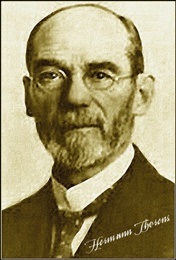
Hermann Thorens 1856-1943
From
the Museum of Music Boxes and Automatons,
Sainte-Croix:
The
clockmaker Antoine Favre-Salomon, a native of
Geneva, invented a musical pock watch in
1796. [He became known as] the "Inventor of
the music box". Sainte-Croix became the
world capital of mechanical music.
--------------------------------
From "Music boxes:
the collector's guide to selecting, restoring, and
enjoying new and vintage music boxes"--Gilbert
Bahl, 1993, Courage Books [with corrections]
"Hermann Thorens Sainte-Croix, Switzerland, 1881-1985. Produced musical movements and music boxes until 1985, when it [the music box concern---not the rest] was bought by Reuge SA. Known for its modern cylinder movements, which are found in many popular collectors' items, such as wooden boxes with revolving tops. The revolving portion often had wooden, hand-carved figures - e.g., Anri - and the base usually had a 28-note movement. The company's movements are also found mounted in a wide range of cases, ranging from simple, well-finished plain boxes to boxes with ornately decorated wooden inlay designs. The disc music boxes were sold under the names Edelwiess and Helvetia. The company was bought by Paillard after WWII [no, 1963 to 1966], and Jean Paul Thorens opened a factory in L' Auberson to produce movements under the trade name Melodies. Trade mark: anchor cast into bedplate of Edelwiess disc machine."
Reuge started in 1886.
----------------------------------
From "Music Boxes: a guide for collectors"--David Tallis, 1971, Stein and Day
Hermann Thorens "Made small
music boxes from 1846 [really? wasn't it 1883?] to
1943 at Ste. Croix"
Ernst Paillard
"Manager of the (Paillard) Ste. Croix works, with his
brother-in-law Eugéne Thorens, forefather of the firm
which exists today."
According
to Moving
Images: From Edison
to the Webcam,
1895 was an extremely bad one for Paillard, Ernest
Paillard, his son, Albert, and
his son-in-law Eugéne
Thorens took over the business. In 1898 they
began the manufacture of the
"Echophon", a small
cylinder phonograph,
and in 1904, the Paillard-Gramophone.( Moving
Images: From
Edison to the
Webcam, John Fullerton,
Astrid Soderbergh
Widding (editors),
Indiana University
Press June 1,
2000.)
----------------------------------
Click on this picture to view a
PDF of a Paillard patent from 1882 which was witnessed
by both Eugéne Thorens and Hermann Thorens:
But the firm we are interested
in is Hermann's which was started in 1883.
Click on the picture below to see a patent from 1897 on a mechanical music toy by Hermann Thorens:
Click on the picture below to
see a 1901 patent by Hermann for a "mechanical musical
instrument" looking like a round disc music box:
Thorens made both cylinder and
disc music box mechanisms.
Below is a nice old box into which someone has inserted a more modern Thorens mechanism. I picked it up around 2004.
It plays five different songs--the pins strike the notes on the comb.
Late in 2009 I picked up the curiousity below. It is a Thorens mechanism in a housing to play "How Dry I Am" while pouring a (presumably alcoholic) beverage.
The person who sold it claims, "After my grandfather came back from WWII his first Christmas present was this unique Silverite liquor bottle stopper and pourer. It plays music when the liquid is poured. It comes in its original gift box with brass tag from the jewelry store and still is in very good working condition. The box is 4 x 5 x 2" and has all its complete corners and is marked Silverite Company, Brooklyn 16, New York and Thorens for its quality music box. The music box works are marked Switzerland Thorens, see photos. When tilted 90 decrees, a brass ball swings inside releasing the mechanism which plays How Dry I Am that sounds like a symphony arrangement in a loud pleasing presentation."
[Well that was another sub-collection started.]
In 2013 I acquired a musical Christmas Bell with a Thorens movement playing "White Christmas". I have since seen a blue one as well. The box shows it is an actual Thorens product and they were at Atlantic and Thorens Ave. in New York.



In 2014 I bought a Schuco Radio 4012 tin toy car. Schuco Radio 4012 and Radio 5000 cars had Thorens music boxes to act as the car's "radio". Mine isn't in the best condition (so far) because I have it as a Thorens artifact and not a tin toy memorabilia. I had to make sure it played that specific car-related tune as I have seen others playing more generic music. The 4012 was made 1952-64. Link to more info is below.

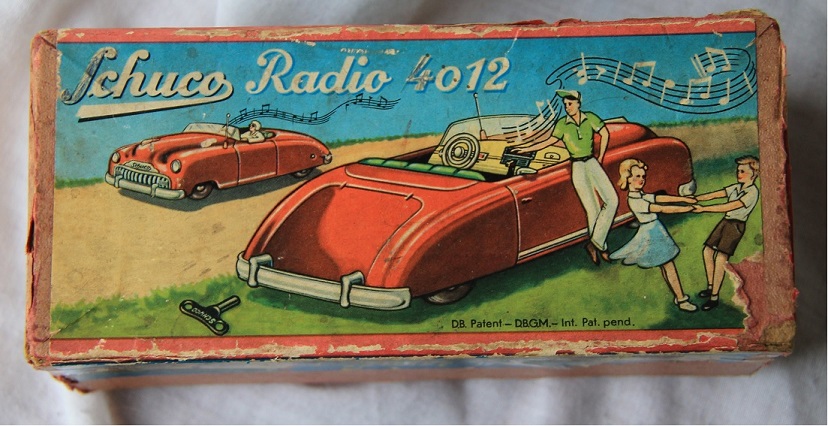

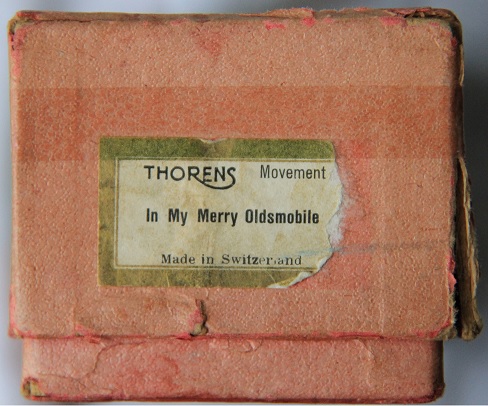
Flip the "radio button" and on comes the Thorens music box music.

Advert from the Milwaukee Journal of
April 28, 1947 (pg. 18):
Click below to see an odd advert
from the April, 1978 edition of Popular Science
for a do-it-yourself music box using Thorens disc
music box works.
But I guess not all their ideas
on music boxes were the best as this incident put them
on page 1 of the Milwaukee
Journal on January 19, 1944:
PLEASE DO NOT
CONTACT ME WITH MUSIC BOX QUESTIONS!
I am no expert on music boxes.
If you have any questions, a
collector I trust swears by Nancy Fratti who can be
found here:
http://www.nancyfrattimusicboxes.com/
An alternative is the Musical Box Society
International: http://mbsi.org/
This page contains some information for restoration
and parts service: http://mysite.verizon.net/cbladey/soundmus/thorensmb.html#History
A short history of Thorens music boxes is found here:
http://www.aerialphotolab.com/Thorens_History.htm
As a quick survey. Thorens music boxes seem to
fall into these categories:
1) Players of metallic discs: a 4.5"
metallic discs with a 30 tooth comb called an
AD30 (AD = Automatic Disc?); and 11" (28cm) disc players, called
"Edelweiss" or AD41. Later bought by Reuge.
An AD30 is below. A great site for
this player is here: http://www.thorensad30.com/
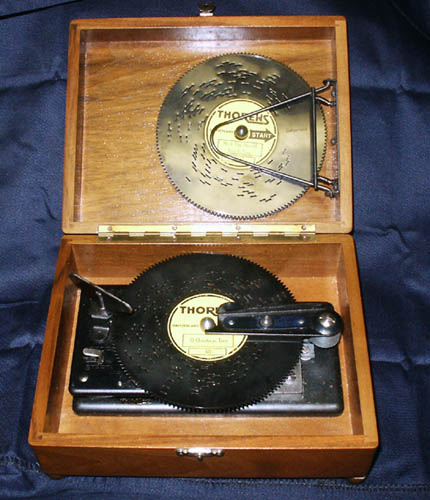
An AD41 is below:
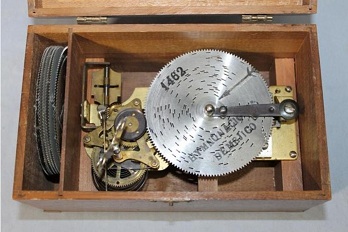
2)
The following cylinder
movements were produced by Thorens and may be in
Thorens-made boxes or those of third-parties:
6 Song undetermined notes "640"
one dated 1960
6 songs, 41 notes “#32”
6 songs, 41 notes "6/41"
6 songs, “AL636”
4 songs, 52 notes “#30” or "No. 30"
4 songs, 52 notes “AL 450”
4 songs,72 notes "No. 35"
4 songs, undetermined notes or model, one dated 1912
3 songs, "3/72"
3 songs, "No. 38"
3 songs, “AL350”
3 songs, “AL336”
2 songs, “A228”
2 songs, “AL236”
2 songs, “AL241”
2 songs, "No. 308"
2 songs, "No. 25"
1 song, “A128”
[The general (but not rigid) pattern
seems to be: first number is the number of songs and
the second number is an indication of teeth
(notes)--although the label I saw of a 308 seems to
break the pattern.]
However, there are also:
3 song "J 942725"
4 song "J 942 730"
3)
Wooden, revolving music figures made by the Italian
firm of Anri (here: http://www.anri.com/) using Thorens
mechanisms. Some examples are found here: http://pinterest.com/102351/music-boxes/
4) Particularly
ornate music boxes commissioned and imported from
India by Fred Zimbalist (a relative of Efram).
There are a number of pages regarding these players
here: http://www.mmdigest.com/Archives/Digests/201105/2011.05.11.02.html
5) As mentioned above, at least two cool toy cars
under the brand "Schuco" contained Thorens music box
movements. A small
picture is below and more info is here.

6)
Musical "Cuckoo clocks" using Thorens movements--picture
pending.
"In 1911, the Swiss manufacturer Thorens exported clockwork motors for use in British-made disk players to the value of £75,000 [M1,875,000 or $375,000]. In comparison, the machine turnover of the British branch of the Gramophone Company was £108,242 [M2,706,050 or $541,210]. However as the prices of Lindström machines were anything up to eighty per cent cheaper than those of the Gramophone Company, the extent of German and Swiss domination of the British and Russian record player trade must have been phenomenal."
Click on this picture to see a PDF of a 1915 patent by Hermann Thorens on a 'frame for the driving mechanism for talking machines':
Click on this picture to see a PDF of a 1917 patent by Hermann Thorens on an 'automatic brake for talking machines':
========================
What I have been able to get so far are: one cylinder phonograph, one spring-driven table-top gramophone, one portable and two 'cameraphones'.
My cylinder player is my latest acquisition.
The machines lid has the top works attached and it is closed by turning it upside down (I understand this is common for French machines).

Reverse the lid and there is the mechanism. It also came with the original box for the reproducer.

And the opriginal horn and this is ready to be wound by a right-handed person and played.

However, the peculiarity of this machine and one other Thorens phonograph is that putting the handle on the other end accommodates left-handed winding.

All known existing versions of this machine are labelled for a London firm of Brown Brothers and was originally sold throughout the UK. Some catalog material from B.B. & Co. showing Thorens products will be uploaded shortly.

The reproducer.

This machine is very much like the "Capital" model in the 1907 catalog here. A generally-accepted identifying feature of Thorens phonographs is the harp-shaped end piece.
A video of the above Cleopatra playing "La Marseillaise" is here.
Here are my table-top, "Crystallin cameraphone" and Excelda together for scale.

This 2007 acquisition is a table top disc gramophone.
Lid and 'volume doors' open.
The decoration on the lid and one door.
Inside the case. The picture is 'upside down' to show the number in the lower corner ('16'). The naked wood on the left is a modification someone has since made to help guide the crank handle. BTW these Thorens 'pillar-and-plate' motors were available into the 1960s (Recently opened 'old stock' boxes had the motors wrapped in newspaper from April, 1960! Here is a motor purchased around 2005. Here you can see the date on the French language newspaper used for wrapping. Courtesy Paul Flint.) and are now being put into machines built to mimic those of the 1900s (in other words, fake antiques, 'crapophones'). Pictures of a fake on ebay are here. A good website on fakes is here.
The motor doesn't have quite the same logo as used elsewhere. Note the anchor.
On the bottom of the inside of the case the number is found again. Is this how they matched up the parts for individual machines? Note how the stain was not applied where we wouldn't see.
The reproducer has the same anchors so we can assume it was also branded for Thorens--it is marked 'made in Switzerland' (I make this point as some machines of this vintage will have parts from various manufacturers 'thrown' together.)
The person who sold this machine to me knew I was interested in the company's history, so he also gave me a letter that was sent to the person who owned it before. This individual wrote to Thorens about the machine in 1965 (when they seemed to still be interested in their history).
And Thorens claims that it was made by them in 1925.
If this is true, Thorens was able to copy Victor's Orthophonic reproducer work extremely quickly as "Victor Day" (when the Orthophonic technology was released to the public) was November 2, 1925. Perhaps this was after 1925. The style is very consistent with many of the machines from Thoren's 1914 catalog (here).
Here is another tabletop Thorens likely of older vintage from John Peel (similar to a Victor Victrola VV-IV).
In 2014 I picked up this 'ultra portable' I call the 'Cristallin' for the name on the reproducer (some sourced call this style a "cameraphone").




With 10" record for scale (yes, I didn't put a needle in the reproducer for the picture):

A video of the above machine is here.
This is machine is very similar to the Thorens "cameraphones" listed at grachonogram.com such as---
L'Argentin" (also named after the reproducer) from 1914 here:
http://www.graphonogram.com/3-id-47-l-argentin.html
Also the later (1929) model "501" here:
http://www.graphonogram.com/3-id-409-modele-no-501.html
And perhaps an early version of the Thorens "Graphonette" shown here:
http://www.grammophon.ch/taschen_grammophone/thorens/thorens.htm
This is my Thorens 'Excelda' 'cameraphone' (picked up around 2004). These were available in black (wooden horn, with mica diaphragms--example from Adrian Smith is here) one source below suggests 1928 and in various colours (and with metal horns and diaphragms) from 1942 to 1947 (one source mentions 1935) (which gives a date to my green one below--here is picture of all colours except the grey of mine below). With it is a Kodak camera of the style it was made to mimic (A Toronto-made No. 1A Pocket Folding camera series II, 1929-31, originally $24.50). More than one gramophone maker made machines that were portable and looked like cameras. Don't ask me why.
The Kodak (which you can also see on the main Family page) opened up.
The Excelda opened up.
The size of the box forces you to put it on the edge of the table to wind. Once wound, you can put it anywhere to play. To wind again, take off the record and put it back on the edge. The 'turntable' is so small that you must screw the record in place to prevent wobble--and the instructions suggested you use a second record under it to help support the one being played and to help regulate the speed.
There's that trademark again.

Excelda adverts ("the word's smallest portable phonograph"!):
Victoria Advocate, June 25, 1946 (pg. 1) on the left and St. Joseph Gazette, July 25, 1946 (pg. 5) on the right.
Youngstown Vindicator, July 16, 1947 (pg. 11).
Here is a PDF of the original Excelda instructions (679kb).
In 2014 I picked up a Soviet copy of the Excelda. The olive color makes it look suspiciously like these were used by the armed forces. Below it is shown beside my Thorens original.
Another example of the Russians (Soviets) copy of this machine is here.
An Excelda-like machine with Thorens parts labelled "Phonopoche" is here.
An Excelda labelled for "Colibri" (or "Hummingbird") for a well-known Belgian firm, which commonly used Swiss parts in ultra-portables is here.
This machine is listed as an "Excleda No. 55" and is a cross between and Excelda and my small machine: No.55
Thorens also made a number of smaller machines, many of which are show here at Graphonogram http://www.graphonogram.com/index.php?genre=0&marque=Thorens&type=0&modele=0&annee=0&pays=0&menu=3&recherche=oui
And here again is...
Here is a very similar Thorens portable from Alexandar Pavlovic
Here is a different but similar Thorens portable from Greg Legault.
Greg's machine looks much like these machines from the Milwaukee Journal of September 17, 1945 (pg. 8)--left--and November 11, 1945 (pg. 21):
-Shelby Sim of Sarnia (via Doug) sends these pictures of a 'Pal Jr.' portable (I thought 'Pal' was a Canadian portable from Compo) with a Thorens motor here.
-Perophone apparently used Thorens motors.
And if you use any of the machines above, you will need to use a new needle for each side of each record. So...
The "200 Forte" tin I picked up from Quebec around 1999 and the others sent from Minnesota, France, England, Australia and Finland in 2009 to 2012. There are more I could collect, shown here, but note the collared tin is not shown (link courtesy of "songster.de the (hopefully) largest Needle Tin Collection online" [only seems to work with Microsoft Exploder]).
I had not previously seen a collared needle (shown):
Detail of a brass container I own, which was called a needle tin but which is actually a container involving lighters -- see below:
Paper holder of Durasteel ("100 plays each!") closed:
My friend Horst has two outside-horn Thorens machines. Click on the machines below to see more pictures.

Thorens made lighters from 1913 to 1964. Here are two Thorens lighters, a display case, a lighter-filler and an advertisement I picked up along with a 1919 Thorens lighter patent.
Thorens made harmonicas from 1914-1921 and 1938-1952. Here is a Thorens harmonica I picked up.
Thorens made skiing equipment 1936 (?) - (?). Here are the drawings from a patent granted in Canada in 1938 for ski bindings.
Thorens made mechanical razors from 1954 to 1960. Here is a Thorens razor I picked up.
In 1928 Thorens developed an electric motor for gramophones and continued on in this business. This motor has also been called the first electric 'direct drive' turntable. There is some dispute as the patent cited is by Paillard and all Thorens patents of this time seem to be acoustic gramophones.
Click the picture below to see a PDF of a patent assigned to "Hermann Thorens Société Anonyme" in 1944 for "an automatic record changer":
Click the picture below to see a PDF of a patent assigned to "Hermann Thorens S.A." in 1945 for a "wireless receiver":
The above looks suspiciously like the top of this 'New Century tuner 1949-1952' on ebay August 2014 (not mine).

Radio museum Thorens info found here: http://radiomuseum.org/m/thorens_ch_en_1.html

And
an
article from the St.
Petersburg Times of February 7, 1960 (pg. 37):
At
some point I acquired two brochures from this era--one
showing the transcription turntable/record player/record
changer lineup and the other giving advice on "HiFi and
your budget". Click to view:


In 1963, Thorens
merged with Paillard SA, Ste.-Croix which at the time
was producing Bolex cameras, Pecisa calulators and
Hermes typewriters. Paillard advert from 1964
below showing Thorens turntable with the other products
(Courtesy: http://www.typewriters.ch/collection/HERMES.html):

In 1966 Thorens
de-merged with Paillard, 'moved' to Germany and merged
with Wilhem Franz's company, EMT, forming
Thorens-Franz AG. There are sources that suggest
this was some how a cost-cutting move to compete with
the Japanese. Thorens would make a big deal about
this after 2000 calling it a return to Switzerland.

Ottawa Citizen,
December 20, 1984. "The 'Better Built' German
Turntable".

They were at the Consumer Electronics Show (CES) as late as 1999. However, they ran into trouble by December 2000 and were looking for new investors ('Das Ende'--according to one German source). Being denied bankruptcy protection in Germany, they restructured and re-launched in 2002 as Thorens Services Ltd. under new management. So "one of the oldest and most experienced manufacturers of sound reproduction equipment in Europe" still lives. Sort of. There is a suggestion that Thorens has become more a label on designed products as turntables bearing that marque are being manufactured by Pro-Ject and Dual (!). (I have read that Thorens TD-170 is actually a re-badged Dual CS-435 and the Thorens 295 MK 4 is a Pro-Ject turntable with a Thorens name.) www.thorens.com does work.
As noted above, a PDF 'magazine' was available for free download from Thorens in 2008. Within it was a bit of company history in their own words as well as some images. The text and images from this article can be found here.
In 2011 three people with the last name Thorens establish a company called "Hermann Thorens SA" with an online presence to sell lighters. See more on my lighter page here.
If you are looking for more information on modern Thorens turntables, start with the Analog Department: http://www.theanalogdept.com/thorens_dept_.htm

